[ad_1]
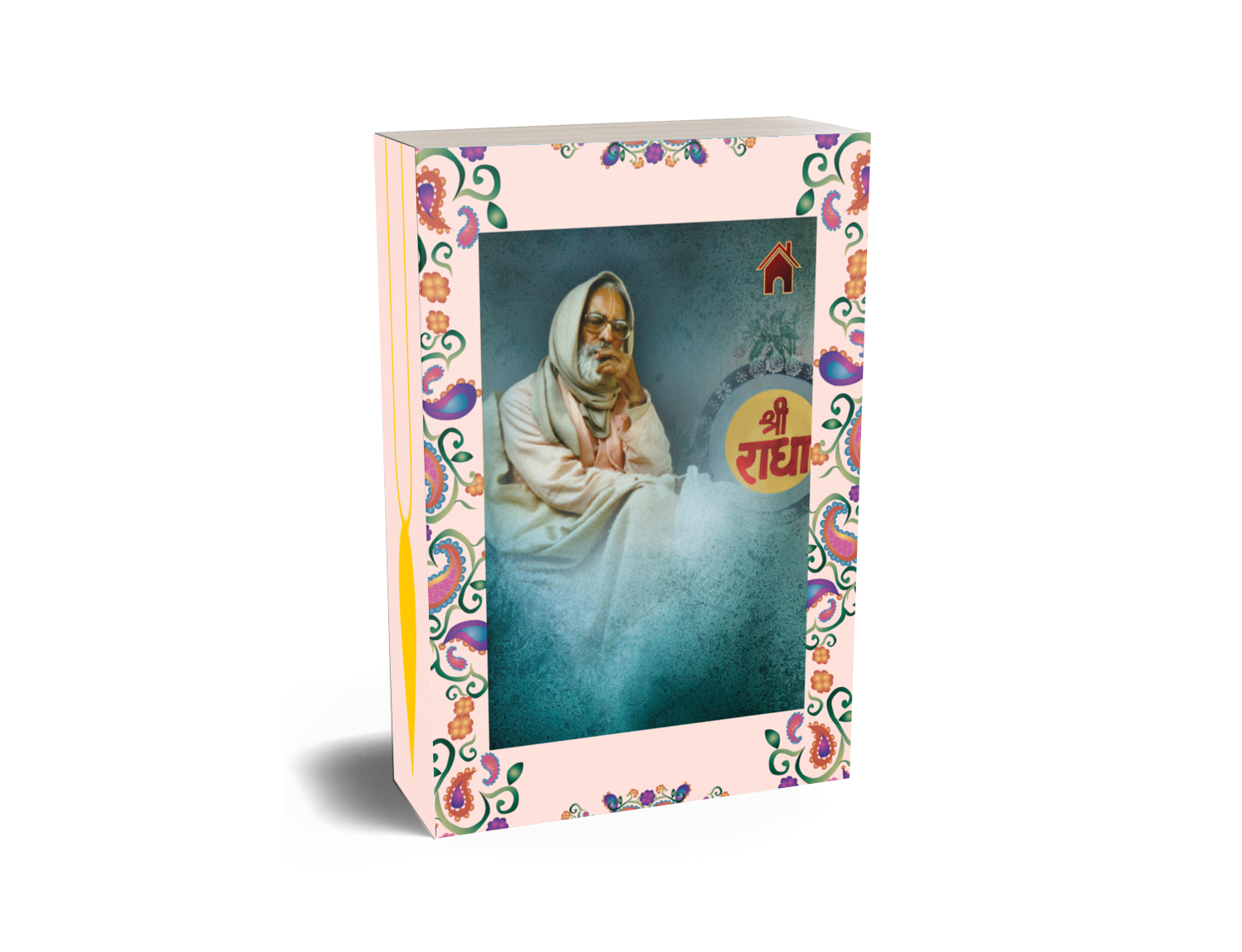

Excerpt from the book Ācārya Kesarī Śrī Śrīmad Bhakti Prajñāna Keśava Gosvāmī – His Life and Teachings, 2nd Edition by Śrīla Bhaktivedānta Nārāyaṇa Mahārāja
Therefore, the śrī vigraha of Bhagavān is the form of eternal existence, cognizance and 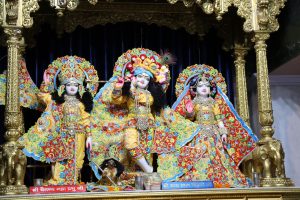 bliss. However, one should bear in mind that only the śrī vigraha established by great liberated personalities are forms of eternality, knowledge and bliss. The mūrti established by conditioned souls is called pratimā, a statue, and the worship of such statues is prohibited in the scriptures. Just as a certified copy of a certified copy is not evidence, a duplicate statue of a deity established by a mahāpuruṣa is not a deity composed of saccid-ānanda. Throughout the śāstras it has been mentioned that endless auspiciousness for the jīvas comes by rendering service to śrī vigraha.
bliss. However, one should bear in mind that only the śrī vigraha established by great liberated personalities are forms of eternality, knowledge and bliss. The mūrti established by conditioned souls is called pratimā, a statue, and the worship of such statues is prohibited in the scriptures. Just as a certified copy of a certified copy is not evidence, a duplicate statue of a deity established by a mahāpuruṣa is not a deity composed of saccid-ānanda. Throughout the śāstras it has been mentioned that endless auspiciousness for the jīvas comes by rendering service to śrī vigraha.

An excerpt from a morning walk with Śrīla Bhaktivedānta Nārāyaṇa Mahārāja in Badger, California, on June 11, 2010, published in Walking with a Saint – Morning Walks and Conversations 2010
Śyāmasundara dāsa: Śrīla Gurudeva, I also have a question about prāṇa-pratiṣṭhā. On page 422 of the biography of your gurudeva, that is, our parama-gurudeva, you quote Parama-gurudeva saying that if the vigraha (Deity) is not installed by a mahā-puruṣa, a fully self-realized soul, then Ṭhākurajī (the Lord in His Deity form) is not present – only a statue is present there. But some persons are saying that if we simply have some faith that Kṛṣṇa is there, then He is there. How do we reconcile that?
Śrīla Bhaktivedānta Nārāyaṇa Mahārāja: That is right. The Deity should be established by 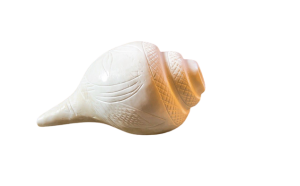 a mahā-puruṣa. It is not that anyone can do this. “Kṛṣṇa se tomāra…” Kṛṣṇa, Govinda, is resting in the heart of the mahā-bhāgavatas, or mahā-puruṣas.
a mahā-puruṣa. It is not that anyone can do this. “Kṛṣṇa se tomāra…” Kṛṣṇa, Govinda, is resting in the heart of the mahā-bhāgavatas, or mahā-puruṣas.
Śrīpāda Āśrama Mahārāja: If a mahā-puruṣa (topmost transcendentalist) doesn’t establish Ṭhākurajī, then is Ṭhākurajī not there?
Vrajanātha dāsa: Gurudeva, Mahārāja is asking that if any general devotee – not a mahā-puruṣa – performs the prāṇa-pratiṣṭhā ceremony, then is Ṭhākurajī not there?
Śrīla Bhaktivedānta Nārāyaṇa Mahārāja: Not there.*
Śrīpāda Āśrama Mahārāja: If people who are worshipping the Deities commit vaiṣṇava-aparādha, offences to any pure devotee, is it possible that Ṭhākurajī may leave, or is He always there?
Śrīla Bhaktivedānta Nārāyaṇa Mahārāja: In that case, there is no use of their Ṭhākurajī worship. If one is committing such aparādha, no fruit will come from such worship and that person will go to hell.
Are there any more questions?
Śrīpāda Āśrama Mahārāja: Sometimes devotees worship their Deities for a long time, and their Ṭhākurajīs are not installed by a mahā-puruṣa. Yet, sometimes Gurudeva has said to continue worshipping Them.
Śrīla Bhaktivedānta Nārāyaṇa Mahārāja: Yes.**
Vrajanātha dāsa: Jñāna-śakti Prabhu is from Canada. He is the father of Kṛṣṇa-prema.
Śrīla Bhaktivedānta Nārāyaṇa Mahārāja: [to Kṛṣṇa-prema dāsa] He is your father? Very good.
[To Jñāna-śakti dāsa] You are happy that he is in the maṭha?
Jñāna-śakti dāsa: Very happy.
Devotee: Gurudeva, if the jīva’s constitutional position is that he is an eternal servant of Kṛṣṇa, then why do some jīvas go to Vaikuṇṭha to serve Nārāyaṇa there?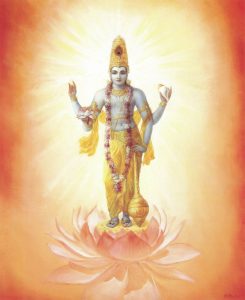
Śrīla Bhaktivedānta Nārāyaṇa Mahārāja: Oh, Nārāyaṇa is Kṛṣṇa. All the manifestations of Kṛṣṇa are Kṛṣṇa, in tattva (by philosophical truth).
Vṛndāvana dāsa (from Hawaii): If a madhyama-adhikārī performs prāṇa-pratiṣṭhā, is there no result?
Śrīla Bhaktivedānta Nārāyaṇa Mahārāja: Yes, there is some result.***

An excerpt from a morning walk with Śrīla Bhaktivedānta Nārāyaṇa Mahārāja in Badger, California, on June 13, 2010, published in Walking with a Saint – Morning Walks and Conversations 2010
Śrīpāda Āśrama Mahārāja: The other day we were discussing Deity worship regarding the 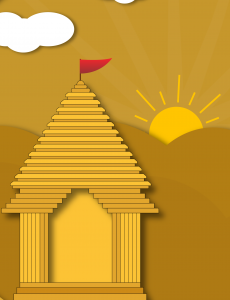 installation of the Deity, or prāṇa-pratiṣṭhā. Suppose a mahā-bhāgavata does the prāṇa-pratiṣṭhā – for instance he installs Śrī Śrī Rādhā-Govinda. Then, for another Deity, general devotees do harināma before the Deity and maybe also some prāṇa-pratiṣṭhā ceremony.
installation of the Deity, or prāṇa-pratiṣṭhā. Suppose a mahā-bhāgavata does the prāṇa-pratiṣṭhā – for instance he installs Śrī Śrī Rādhā-Govinda. Then, for another Deity, general devotees do harināma before the Deity and maybe also some prāṇa-pratiṣṭhā ceremony.
Kṛṣṇa is there in that Deity of the general devotees and also in the Deity of the mahā-bhāgavata, but what is the speciality of that prāṇa-pratiṣṭhā of that mahā-bhāgavata, who has his worshipful Lord, or Deity, in his heart? General devotees cannot bring the Lord out from their hearts. So what is the difference in the mūrti?
Śrīla Bhaktivedānta Nārāyaṇa Mahārāja: In the form of a Deity, Kṛṣṇa told Sanātana  Gosvāmī, “You are not giving Me even salt?” Sanātana Gosvāmī then asked the Deity, “From where will I get salt?”
Gosvāmī, “You are not giving Me even salt?” Sanātana Gosvāmī then asked the Deity, “From where will I get salt?”
Śrīpāda Mādhava Mahārāja: “Today you are asking for salt, tomorrow it will be sugar.”
Śrīla Bhaktivedānta Nārāyaṇa Mahārāja: The Deity replied, “Oh, but what if I will arrange this Myself?” Sanātana Gosvāmī said, “Oh, You can do that. You are the Supreme Lord.” Thus, Kṛṣṇa made the arrangement.****
The Ṭhākura (Deity) of an uttama-adhikārī, or even a madhyama-adhikārī, has a speciality. He can speak or do anything in order to reciprocate with His devotee. For a kaniṣṭha-adhikārī, He will not do so.
Even if an uttama-adhikārī worships grass, thinking it to be Kṛṣṇa, this is so much better  than the kaniṣṭha adhikārī’s worship of the Deity in His original form. For that devotee, Kṛṣṇa acts even through grass.
than the kaniṣṭha adhikārī’s worship of the Deity in His original form. For that devotee, Kṛṣṇa acts even through grass.
Śrīpāda Āśrama Mahārāja: Is this because an uttama-adhikārī has the mood of sarva-bhūteṣu yaḥ paśyed?
sarva-bhūteṣu yaḥ paśyed
bhagavad-bhāvam ātmanaḥ
bhūtāni bhagavaty ātmany
eṣa bhāgavatottamaḥ
Śrīmad-Bhāgavatam (11.2.45)
[One who sees his own mood of attraction for Śrī Kṛṣṇacandra, the Soul of all souls, in all jīvas, and who also sees all living entities residing within the shelter of Śrī Kṛṣṇa, is an uttama-bhāgavata.]
Śrīla Bhaktivedānta Nārāyaṇa Mahārāja: This is certainly true for an uttama-adhikārī. If the devotee is really madhyama-madhyama (an intermediate-intermediate devotee) or madhyama-uttama (the highest of the intermediate devotees), who is just about to become an uttama devotee, then his Deity installation (vigraha prāṇa-pratiṣṭhā) is also accepted as bona fide. He has something – a special attachment towards Kṛṣṇa.
Śrīpāda Āśrama Mahārāja: Kṛṣṇa is everywhere. So, if a general devotee is doing prāṇa-pratiṣṭhā, the installation ceremony…
Śrīla Bhaktivedānta Nārāyaṇa Mahārāja: We are madhyama-adhikārīs. I am madhyama-adhikārī…
Devotees: No, no, no.
Śrīla Bhaktivedānta Nārāyaṇa Mahārāja: …but still, I perform this ceremony around the world.
Tri-lokanātha dāsa: You are uttama-uttama (the topmost of the topmost devotees), Śrīla Gurudeva.
* Ṭhākurajī is always present everywhere, even without installation, because Kṛṣṇa is 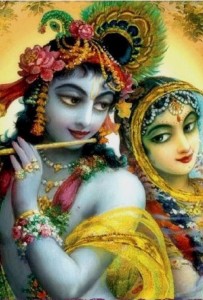 present in each and every atom. But Gurudeva is saying here that only the mahā-bhāgavata devotee can invite that Ṭhākurajī – Rādhā-vallabha, Rādhā-Govinda, etc. – from his heart into the mūrti. Others, those who are not mahā-bhāgavatas, cannot do so because they have not yet conquered that Ṭhākurajī within their heart. Of course, each and every person is only allowed to interact with the Supreme Lord according to his level of advancement, but if the Deities are properly installed by the mahā-bhāgavata Vaiṣṇava, Their darśana is spiritually very potent.
present in each and every atom. But Gurudeva is saying here that only the mahā-bhāgavata devotee can invite that Ṭhākurajī – Rādhā-vallabha, Rādhā-Govinda, etc. – from his heart into the mūrti. Others, those who are not mahā-bhāgavatas, cannot do so because they have not yet conquered that Ṭhākurajī within their heart. Of course, each and every person is only allowed to interact with the Supreme Lord according to his level of advancement, but if the Deities are properly installed by the mahā-bhāgavata Vaiṣṇava, Their darśana is spiritually very potent.
An excerpt from Jaiva-dharma, Chapter 11:
The Deity form is always cinmaya (spiritual and conscious) for those who are on the highest platform of eligibility. Those on the intermediate level see the Deity as endowed with perception and awareness (manomaya). This means that the intermediate devotee has faith that the Deity is conscious of his thoughts and prayers, and accepts his mood of worship. However, the intermediate devotee, unlike the advanced devotee, does not directly perceive the Deity as the spiritual all-conscious form of Bhagavān. Those on the lowest level initially see the Deity as material (jaḍamaya), but in time, the Deity reveals His pure spiritual form to the intelligence purified by spiritual love. Consequently, the Deity form of Bhagavān is suitable to be worshipped and served by all classes of devotees. It is unnecessary to worship an imaginary form, but it is highly beneficial to worship Bhagavān’s eternal Deity form.
An excerpt from Jaiva-dharma, Chapter 11:
The irrevocable conclusion is that sat-saṅga is the root of all spiritual advancement. When one associates with bhaktas of Bhagavān who are fully situated in divine consciousness, one awakens transcendental affection toward Bhagavān. The more this transcendental affection increases, the more the material idea of the Deity vanishes and through great good fortune this divine consciousness gradually unfolds.
** By such worship a person’s life will become regulated.
*** This is Vedic culture. He is under the guidance of the uttama-adhikārī. He is remembering his gurudeva, thinking, “You are doing this, and we are helping.” Some result will be there. Everything depends on the degree of surrender of that madhyama-adhikārī to his gurudeva.
**** An excerpt from Vraja-maṇḍala Parikramā, Part 2, Chapter 19:
Sometimes in the morning, Śrī Sanātana Gosvāmī walked the sixteen miles from Vṛndāvana  to Govardhana to perform the fourteen-mile-long parikramā of Govardhana. From there, he would walk another sixteen miles to Mathurā to collect alms (mādhukarī) and then again walk back to his bhajana-kuṭī in Vṛndāvana. One day, he came to the house of a Caube brāhmaṇa in Mathurā for alms. What did he see there? In the house of the Caube, two beautiful boys were playing the game gullī-daṇḍā. Madana, the restless, fidgety boy with a dark-bluish complexion defeated the son of the Caube. Madana climbed upon the shoulders of the defeated boy and enjoyed a ‘horse ride’. But when the Caube’s son defeated Madana the second time they played, and it was his turn to enjoy a ride on Madana’s shoulders, Madana ran into the temple room. Seeing this, the son of the Caube angrily abused and pursued Him. He wanted to enter the temple, but the priest scolded him and chased him away. Pointing his forefinger at Madana, who had turned into the Deity, the son of the Caube said, “You just wait, I will see You tomorrow!”
to Govardhana to perform the fourteen-mile-long parikramā of Govardhana. From there, he would walk another sixteen miles to Mathurā to collect alms (mādhukarī) and then again walk back to his bhajana-kuṭī in Vṛndāvana. One day, he came to the house of a Caube brāhmaṇa in Mathurā for alms. What did he see there? In the house of the Caube, two beautiful boys were playing the game gullī-daṇḍā. Madana, the restless, fidgety boy with a dark-bluish complexion defeated the son of the Caube. Madana climbed upon the shoulders of the defeated boy and enjoyed a ‘horse ride’. But when the Caube’s son defeated Madana the second time they played, and it was his turn to enjoy a ride on Madana’s shoulders, Madana ran into the temple room. Seeing this, the son of the Caube angrily abused and pursued Him. He wanted to enter the temple, but the priest scolded him and chased him away. Pointing his forefinger at Madana, who had turned into the Deity, the son of the Caube said, “You just wait, I will see You tomorrow!”
This scene amazed Śrī Sanātana Gosvāmī. The next day, he arrived a little earlier, at 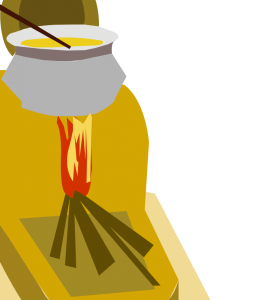 breakfast time, desiring to again have darśana. Although she had not yet taken bath, the Caubāin was making khichrī for both boys, who were sitting and waiting for their breakfast. Maiyā was brushing her teeth with one end of a stick and stirring the khichrī with the other end. When she had finished cooking, she served the boys the hot khichrī in bowls, cooling it down by blowing on it with her mouth. The boys were relishing this khichrī with great love.
breakfast time, desiring to again have darśana. Although she had not yet taken bath, the Caubāin was making khichrī for both boys, who were sitting and waiting for their breakfast. Maiyā was brushing her teeth with one end of a stick and stirring the khichrī with the other end. When she had finished cooking, she served the boys the hot khichrī in bowls, cooling it down by blowing on it with her mouth. The boys were relishing this khichrī with great love.
Sanātana Gosvāmī could not tolerate her improper conduct. “Maiyā, it is not proper to cook khichrī without taking bath, to stir it with the stick you use to brush your teeth, and then to serve this contaminated breakfast to the boys.”
The Caubāin realized her mistake, and replied, “Bābā, from tomorrow, I will be clean when I cook and serve the boys their breakfast.”
Śrī Sanātana Gosvāmī wanted to see some more pastimes of the Deity of Śrī Madana-Mohana, so on the third day he went there again. Breakfast was delayed that day because Maiyā was taking bath. She then had to clean the pots. The hungry boys were demanding breakfast. Maiyā pacified them, and after completing her morning chores, she started cooking khichrī. The two boys were pulling on her cloth and insisting on eating at once. Sanātana Gosvāmī was unable to tolerate this. He approached her and said, “Maiyā, there is no need for you to be clean by bathing and so forth. If this Madana is pleased with your unclean and impure breakfast, then you should do as such. I have committed an offence at your feet. From tomorrow, you should do whatever you think is proper to satisfy them.”
Just as Sanātana Gosvāmī was about to leave, the boy Madana came out of the temple room and said, “Bābā, I will come with you.”
But Śrī Sanātana Gosvāmī replied, “I am a completely renounced person. I have neither a place to live, nor any arrangement to cook palatable food. If even Yaśodā-maiyā could not completely satisfy You, how can I take care of You?” The child Madana nonetheless insisted on coming with him. Sanātana Gosvāmī said, “If You really want to come, then You will have to follow me on foot. I cannot carry You on my shoulders.”
The boy said, “I will walk behind you, but don’t turn around along the way to look at Me. You can look at Me only at your bhajana-kuṭī.”
When Sanātana Gosvāmī had reached his bhajana-kuṭī, he turned around and saw the boy Madana smile and change into His Deity form. Sanātana Gosvāmī constructed an altar by putting a board on top of a few stones and seated Him there. Every day, he would cook some balls of dough without salt on live coals, and offer them to the Deity. One day, as Sanātana Gosvāmī was making his offering, Madana-Mohanajī asked him for some salt. Sanātana Gosvāmī would happily have given salt if only he had some, but there was no salt in the hut. Madana-Mohanajī told him, “I am not able to swallow this dry dough ball.” Upon hearing this, Sanātana Gosvāmī began to repent.
At that time, Kṛṣṇadāsa Kapūra, a rich merchant from the Multāna province, happened to be  travelling along the Yamunā carrying valuable articles for trade in large boats. As the boats approached Sanātana Gosvāmī’s bhajana-kuṭī, they got stuck in the sand. Despite several efforts, the boats could not be released from the sand. The merchant came ashore and saw the extremely beautiful Deity of Śrī Madana-Mohana in front of the hut. Sitting down on the invitation of Sanātana Gosvāmī, the merchant began to weep and lament to him about his situation. In his mind, he firmly vowed, “As soon as my boats are freed from the sand, I will construct a beautiful temple for Śrī Madana-Mohana with the profits I make from this journey. I will also make proper arrangements for His service and offerings.” The moment he resolved this, his boats were dislodged and started drifting again. He made an enormous profit from his trade and, on the inspiration of Śrī Sanātana Gosvāmī, constructed a huge temple for Śrī Madana-Mohana. However, Śrī Sanātana Gosvāmī entrusted all the arrangements of service, worship, offering, and so forth to the priests and again began performing mādhukarī in Vraja. In this way, he maintained his life by living under a different tree every night and performing rigid sādhana-bhajana.
travelling along the Yamunā carrying valuable articles for trade in large boats. As the boats approached Sanātana Gosvāmī’s bhajana-kuṭī, they got stuck in the sand. Despite several efforts, the boats could not be released from the sand. The merchant came ashore and saw the extremely beautiful Deity of Śrī Madana-Mohana in front of the hut. Sitting down on the invitation of Sanātana Gosvāmī, the merchant began to weep and lament to him about his situation. In his mind, he firmly vowed, “As soon as my boats are freed from the sand, I will construct a beautiful temple for Śrī Madana-Mohana with the profits I make from this journey. I will also make proper arrangements for His service and offerings.” The moment he resolved this, his boats were dislodged and started drifting again. He made an enormous profit from his trade and, on the inspiration of Śrī Sanātana Gosvāmī, constructed a huge temple for Śrī Madana-Mohana. However, Śrī Sanātana Gosvāmī entrusted all the arrangements of service, worship, offering, and so forth to the priests and again began performing mādhukarī in Vraja. In this way, he maintained his life by living under a different tree every night and performing rigid sādhana-bhajana.
Source: Purebhakti.com
Image/Art made possible by Pixabay.com, Krishnapath.org and/or Bhaktiart.net
[ad_2]
#compilation #instructions #relation #śrī #vigrahatattva






